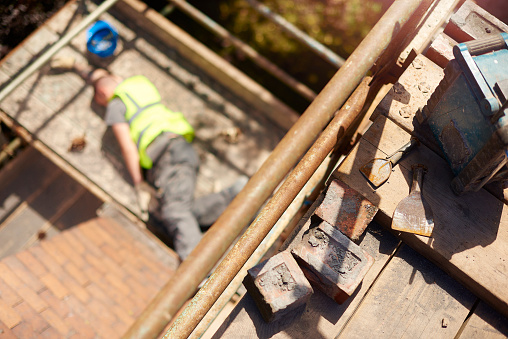Falls Are the Leading Cause of Death in Construction

Construction accidents often involve falls from ladders, scaffolding, roofs
If you work in the construction industry, a fall from height is a fatal hazard that you're faced with on many days. Data shows that falls are the leading cause of death in construction accidents. In 2020, there were a total of 1,008 construction fatalities—351 of which were the result of falls.
Focusing on and studying the areas where most falls occur is a critical step toward creating a safe workplace and preventing construction accidents involving falls. Unprotected side and edges, overhand bricklaying and related work, roof work on low-slope roofs, and holes are considered the most dangerous areas on a construction site, according to the Industrial Safety & Hygiene News (ISHN).
Unprotected sides and overhand bricklaying
Unprotected sides and edges expose construction workers to the dangers below. There are three types of fall protection systems to ensure the safety of workers:
- Guardrail systems
- Safety net systems
- Personal fall arrest systems
These systems should all be added to the construction site before any work begins and maintained until all work is completed.
Protection while on an overhand bricklaying job is similar to jobs that may have unprotected sides. All three systems listed above can help protect employees from hazardous heights, with the addition of controlled access zones.
Sometimes guardrails and safety nets cannot be used in certain areas. A controlled access zone only allows specific essential workers in and prohibits those not approved from entering.
Roof work on low-slope roofs
To protect workers when they are working on low-slope roofs, the following can be implemented:
- Guardrail systems
- Safety net systems
- Personal fall arrest systems
- A combination of these systems with warning lines
How employers can prevent falls
The Occupational Safety and Health Administration (OSHA) lists 3 steps to prevent workplace falls: planning, providing, and training.
Planning ensures the job gets done safely. Knowing the steps it will take to complete a job and the safety equipment needed can stop fatal falls from happening.
Providing the right equipment like ladders, scaffolds, and safety gear can help protect construction workers as they work and help prevent them from falling.
Training every worker is essential in any job, but crucial in construction. Every construction worker should be properly trained on setting up equipment and how to properly use it.
Talk to a Pennsylvania construction accident attorney
If you fell on the job site and were injured in a construction accident, you may be eligible for workers' compensation benefits. If someone from another company is responsible for your accident (e.g., a subcontractor), you may also be able to file a third-party lawsuit, which can provide compensation for damages not covered by workers' comp, such as pain and suffering.
Likewise, if a loved one died in a construction accident, you may have a few different legal options to consider. The important thing to remember is that you should talk to a construction accident lawyer to get a clear understanding of your legal rights.
At Vellner Law, PC we've successfully handled complicated construction accident cases in Pennsylvania for decades. We know how the legal system works here, and we will guide you through every step of the process. Your fight is our fight, and we will leave no stone unturned to get the outcome your case deserves.
Contact us today for a free consultation with an experienced construction accident lawyer. We have offices in Allentown and Bethlehem, and we proudly represent injured workers throughout the entire Lehigh Valley.
